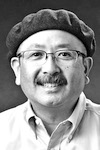
Gil Asakawa
I’ve been following the worldwide career of Marie Kondo with bemusement since her first book, “The Life-Changing Magic of Tidying Up,” was published in the U.S. in 2014. I’ve watched from a distance as friends have embraced Kondo’s single-minded prescription for people to clean up their lives, physically and therefore emotionally, by focusing not on what to toss out but instead what to keep that “sparks joy” for them.
I’ve followed this fad sweep the world from afar because, frankly, I’m not a tidy person.
Recently, I’ve gotten a better introduction to Kondo as a personality and her somewhat complicated relationship to Americans through her Netflix series “Tidying Up With Marie Kondo.”
In the series, she visits the home of people in the Los Angeles area, where she now lives, ranging from a Japanese American couple of empty-nesters to an African-American family, a gay couple, a lesbian couple, a widow awash in her late husband’s presence — a veritable cornucopia of diversity, equity and inclusion. Each episode tugs at the heart and gives lots of tips and ideas for viewers to tidy up their homes … and lives.
The series has led to Kondo becoming a fulcrum for racial and anti-Japanese sentiment in the past few weeks because of a controversial tweet (now-deleted) by American social justice, feminist and socialist author and intellectual Barbara Ehrenreich. “I will be convinced that America is not in decline only when our decluttering guru Marie Kondo learns to speak English,” she wrote.
After a torrent of criticism calling out the inherent racism in her comment, Ehrenreich took down her tweet and posted a nonapology: “I confess: I hate Marie Kondo because, aesthetically speaking, I’m on the side of clutter. As for her language: It’s OK with me that she doesn’t speak English to her huge American audience, but it does suggest that America is in decline as a superpower.”
That view of diminishing American “power” is as old school as the Cold War, a shocking and disappointing backward worldview coming from someone who’s supposedly progressive, liberal and forward-looking. And, it reveals that the ugly racist underside of the “politically correct” façade can still fester just beneath the surface of not just white supremacists but also people who should know better.
The fact that Netflix chose to have an interpreter on the show and have Kondo speak much of the time in Japanese (she can speak English, but is probably shy about using English — a typical Japanese trait of self-effacement) is a great sign that America is becoming more tolerant and not slipping in stature in the world.
The show has gotten positive reviews outside of Ehrenreich’s dumb comment, so her language isn’t hurting Kondo’s celebrity brand. Her Japanese is either interpreted by Marie Iishi, who is awesome at converting Kondo’s rapid-fire Japanese into unstilted conversational English or translated into captions on the screen. Anyone who’s watched a Japanese movie or anime with subtitles would not think this is a sign of the decline of Western Civilization, by any means.
Kondo’s a perfect package for Western television: She’s almost pixielike in her tiny physical presence, but she commands a powerful, confident space as a personality. She has mastered her processes and can show people worldwide with or without language barriers how to fold clothes or use small boxes to organize the flotsam and jetsam of an unruly kitchen pantry shelf.
Her “KonMari” method — short for her proper name in Japanese, Kondo Mariko (family name first) — is a brilliant marketing distillation of the compulsive obsessions that caused her as a child to toss out half of her mother’s things when she went on vacation, or caused her to straighten out her elementary school bookshelves, mixed with traditional Japanese cultural values. Or, at least, Shinto spiritual traditions, which demand cleanliness.
Kondo worked for five years at a Shinto shrine and was also inspired by the religion’s animist traditions (hence, Kondo greets the homes she enters, and urges clients to thank the items they’re not going to keep).
Her method makes perfect sense if you’re interested in cutting clutter in your environment. Instead of tossing out as much as you can stand, Kondo’s brilliant perspective is to decide what you want to keep — by seeing if those items, books, photos or clothes “spark joy” in you. It’s a positive affirmation of embracing the things in your life that matter, not a guilt-tripping need to cut away stuff willy-nilly.
But the KonMari method isn’t for everyone.
For instance, I’ve never known a single journalist — including myself — whose desk didn’t look like the aftermath of a natural disaster. We like it that way. My surroundings would probably give Kondo a heart attack.
So, I appreciate her stardom and am glad for Kondo’s growing empire of tidy people. She’s bringing Japanese values — and her quirky take on them — to America. But I’m happy to watch her from amidst my papers, cables, gadgets and stacks of stuff, thank you very much.
Gil Asakawa is former chair of the Pacific Citizen Editorial Board and author of “Being Japanese American” (Second Edition, Stone Bridge Press, 2015). He blogs at www.nikkeiview.com.



